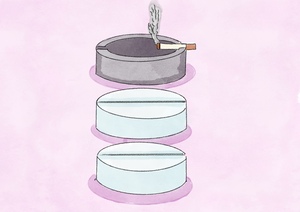How smoking and quitting impact on psychotropic and other medications (useful to know)
Cigarette smoke contains about 3,000 different chemicals. Some of these chemicals can interact with the medications, and a few of these interactions can be quite significant.
The main responsible are chemicals called polycyclic aromatic hydrocarbons (PAHs). These PAHs can change the way the body processes certain drugs. Here’s how it works:
PAHs activate liver enzymes. When these enzymes are activated, they can speed up the metabolism of drugs that use these pathways, lowering the drug levels in the blood.
Heavy smokers and those who smoke unfiltered cigarettes have higher levels of enzyme activation. The more you inhale, the more PAHs get into your system, leading to greater enzyme induction.
When you quit smoking, these enzyme levels quickly return to normal. The activity of some enzymes drops to steady levels within a week after quitting. As a result, drug levels in the blood can increase when one stops smoking, which might lead to higher chances of side effects or toxicity.
Even though we know this, there aren’t clear guidelines for how to manage medications when you quit smoking because specific studies on these interactions are still lacking.
So, if a person you’re caring for is a smoker or planning to quit, it’s essential to talk to the doctor about the medications and how to avoid potential issues.
What to know about medications when stopping smoking?
Amount of tobacco smoked:
Heavy smokers are at the highest risk for drug interactions.
Drug metabolism:
The impact is greatest for medications that rely heavily on some enzymes and the doctor will advise and inform you regarding the medication.
Method of quitting:
Whether quitting abruptly or gradually, it can sometimes influence the medications.
Enzyme changes:
It takes at least one week for changes in enzyme activity to take place after stopping smoking.
Medication Dosage:
High doses of antipsychotic medications may lead to unpredictable increases in drug levels.
Liver function:
The baseline liver health can affect how drugs are processed.
Age:
The ability of your body to induce some enzymes decreases as you get older.
Considering these factors can help manage the medicationsmore effectively during smoking cessation.
It is recommended to always discuss any changes in the smoking habits of thepatient with the healthcare provider to ensure safe and effective treatment.


